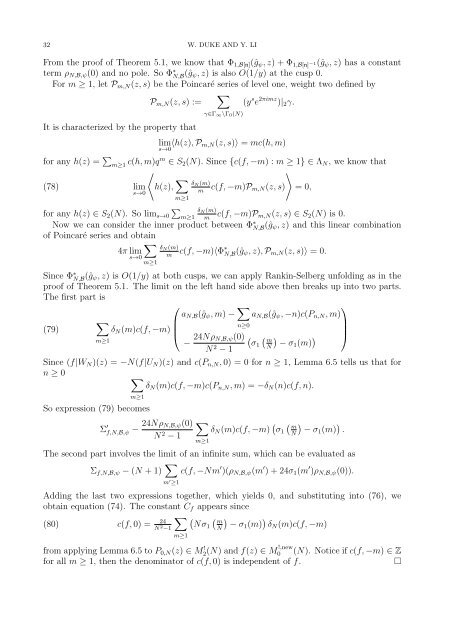Mock-modular forms of weight one - UCLA Department of Mathematics
Mock-modular forms of weight one - UCLA Department of Mathematics
Mock-modular forms of weight one - UCLA Department of Mathematics
You also want an ePaper? Increase the reach of your titles
YUMPU automatically turns print PDFs into web optimized ePapers that Google loves.
32 W. DUKE AND Y. LI<br />
From the pro<strong>of</strong> <strong>of</strong> Theorem 5.1, we know that Φ 1,B[n] (ĝ ψ , z) + Φ 1,B[n] −1(ĝ ψ , z) has a constant<br />
term ρ N,B,ψ (0) and no pole. So Φ ∗ N,B (ĝ ψ, z) is also O(1/y) at the cusp 0.<br />
For m ≥ 1, let P m,N (z, s) be the Poincaré series <strong>of</strong> level <strong>one</strong>, <strong>weight</strong> two defined by<br />
∑<br />
P m,N (z, s) := (y s e 2πimz )| 2 γ.<br />
It is characterized by the property that<br />
γ∈Γ ∞\Γ 0 (N)<br />
lim 〈h(z), P m,N(z, s)〉 = mc(h, m)<br />
s→0<br />
for any h(z) = ∑ m≥1 c(h, m)qm ∈ S 2 (N). Since {c(f, −m) : m ≥ 1} ∈ Λ N , we know that<br />
〈<br />
(78) lim h(z), ∑ 〉<br />
δ N (m)<br />
c(f, −m)P<br />
s→0 m m,N(z, s) = 0,<br />
m≥1<br />
δ N (m)<br />
m c(f, −m)P m,N(z, s) ∈ S 2 (N) is 0.<br />
for any h(z) ∈ S 2 (N). So lim s→0<br />
∑m≥1<br />
Now we can consider the inner product between Φ ∗ N,B (ĝ ψ, z) and this linear combination<br />
<strong>of</strong> Poincaré series and obtain<br />
∑<br />
δ<br />
4π lim N (m)<br />
c(f,<br />
s→0 m −m)〈Φ∗ N,B(ĝ ψ , z), P m,N (z, s)〉 = 0.<br />
m≥1<br />
Since Φ ∗ N,B (ĝ ψ, z) is O(1/y) at both cusps, we can apply Rankin-Selberg unfolding as in the<br />
pro<strong>of</strong> <strong>of</strong> Theorem 5.1. The limit on the left hand side above then breaks up into two parts.<br />
The first part is<br />
⎛<br />
a N,B (ĝ ψ , m) − ∑ a N,B (ĝ ψ , −n)c(P n,N , m)<br />
∑<br />
⎜<br />
n≥0<br />
⎟<br />
(79)<br />
m≥1<br />
δ N (m)c(f, −m) ⎜<br />
⎝<br />
− 24Nρ N,B,ψ(0)<br />
N 2 − 1<br />
(<br />
σ1<br />
( m<br />
N<br />
⎞<br />
)<br />
− σ1 (m) ) ⎟<br />
⎠<br />
Since (f|W N )(z) = −N(f|U N )(z) and c(P n,N , 0) = 0 for n ≥ 1, Lemma 6.5 tells us that for<br />
n ≥ 0<br />
∑<br />
δ N (m)c(f, −m)c(P n,N , m) = −δ N (n)c(f, n).<br />
m≥1<br />
So expression (79) becomes<br />
Σ ′ f,N,B,ψ − 24Nρ N,B,ψ(0)<br />
N 2 − 1<br />
∑<br />
δ N (m)c(f, −m) ( (<br />
σ m<br />
)<br />
1 N − σ1 (m) ) .<br />
m≥1<br />
The second part involves the limit <strong>of</strong> an infinite sum, which can be evaluated as<br />
Σ f,N,B,ψ − (N + 1) ∑ m ′ ≥1<br />
c(f, −Nm ′ )(ρ N,B,ψ (m ′ ) + 24σ 1 (m ′ )ρ N,B,ψ (0)).<br />
Adding the last two expressions together, which yields 0, and substituting into (76), we<br />
obtain equation (74). The constant C f appears since<br />
∑ ( (<br />
(80) c(f, 0) = 24<br />
m<br />
)<br />
N 2 Nσ1<br />
−1<br />
N − σ1 (m) ) δ N (m)c(f, −m)<br />
m≥1<br />
from applying Lemma 6.5 to P 0,N (z) ∈ M 2(N) ! and f(z) ∈ M !,new<br />
0 (N). Notice if c(f, −m) ∈ Z<br />
for all m ≥ 1, then the denominator <strong>of</strong> c(f, 0) is independent <strong>of</strong> f.<br />
□
















